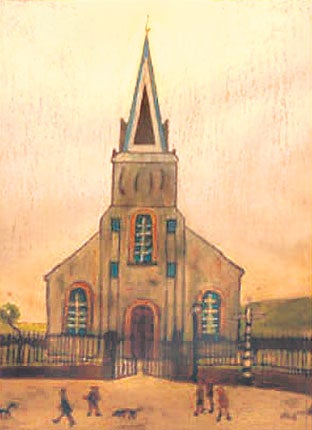Immortalised by Lowry – but the painting costs more

Your support helps us to tell the story
From reproductive rights to climate change to Big Tech, The Independent is on the ground when the story is developing. Whether it's investigating the financials of Elon Musk's pro-Trump PAC or producing our latest documentary, 'The A Word', which shines a light on the American women fighting for reproductive rights, we know how important it is to parse out the facts from the messaging.
At such a critical moment in US history, we need reporters on the ground. Your donation allows us to keep sending journalists to speak to both sides of the story.
The Independent is trusted by Americans across the entire political spectrum. And unlike many other quality news outlets, we choose not to lock Americans out of our reporting and analysis with paywalls. We believe quality journalism should be available to everyone, paid for by those who can afford it.
Your support makes all the difference.Getting L S Lowry to paint your house – that would knock the price up a bit. And so it proved yesterday, as a church immortalised by the artist sold at auction for almost £30,000 more than its valuation.
Nevertheless, the £99,000 sale price of the tiny country church in Cumbria is just a fraction of the value of Lowry's painting itself.
Lowry, who became famous for his gritty portraits of pre-war industrial life in the smoke stacks of Salford, and his matchstick men and matchstick cats and dogs, came across Wath Brow Mission near Cleator Moor in 1948 while visiting his friend Geoffrey Bennett, at one time manager of the Cleator Moor Westminster Bank. The artist was impressed by the building and painted it in typically dark style.
The 300-seat church, opened in 1881, has reportedly been suffering from dry rot and an unsafe bell tower and it is thought that repairs would cost tens of thousands of pounds. The Church of England deemed the building surplus to requirements. It was sold on the condition that the new owners would leave the famous Lowry façade intact.
It is unclear what the new owner intends to do with the property, but auctioneer Colin West of Auction House Cumbria, which sold the church, had predicted it would garner interest from a buyer wanting to convert it into a house. The local council has indicated it would be happy for that redevelopment to go ahead.
"Alternatively, maybe we will get a real Lowry enthusiast who just wants to keep it as it is," said Mr West. "At the moment it still has the pulpit, the altar and all the pews.
"Everybody in the town knows the church and you get tourists come to look at it all the time because it is on the official Lowry trail.
"There are great views over the fells from the rear. It is absolutely beautiful. We are going to get a huge amount of interest."
In May, three works by Lowry sold for more than £1m in an auction at Sotheby's in London. The Street Brawl sold for £657,250, more than £100,000 over its estimated price. Street Scene with Mill went for £397,250 and Man Walking for £145,250. However, a fourth work – A Protest March – failed to sell. It had been valued between £300,00 and £500,000. None of the paintings had been put on the auction market before.
In 2009, L S Lowry's 1935 painting of Berwick-upon-Tweed's marketplace sold for £541,250, £40,000 more than the estimated price. Earlier this month, it was reported that a painting believed to be Lowry's first watercolour was to go on sale.
A Group of Five Figures, painted in 1952, is being offered for £65,000. Lowry is said to have painted it after a schoolgirl taunted him by saying: "You can't be very famous. No one at school has ever heard of you," prompting the artist to borrow her paintbox.
Lowry did not often paint watercolour. He explained: "They don't really suit me – dry too quickly. They're not flexible enough. I like a medium you can work into over a period of time."
A spokesman for the Diocese of Cumbria was not available for comment. Lowry died in 1976.
Join our commenting forum
Join thought-provoking conversations, follow other Independent readers and see their replies
Comments